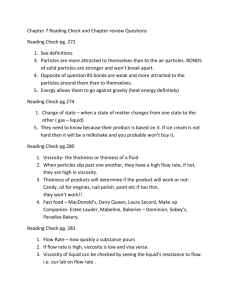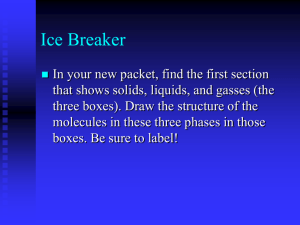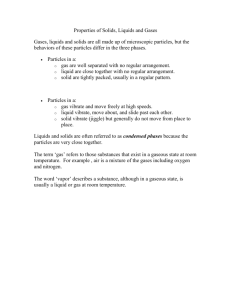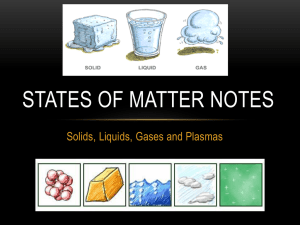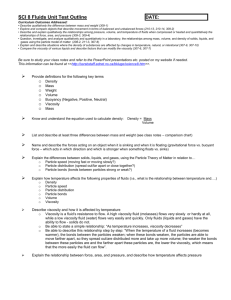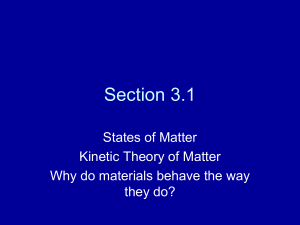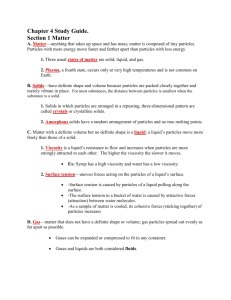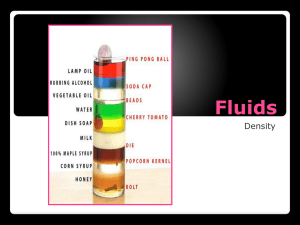1) Why is a solid not considered a fluid?
advertisement
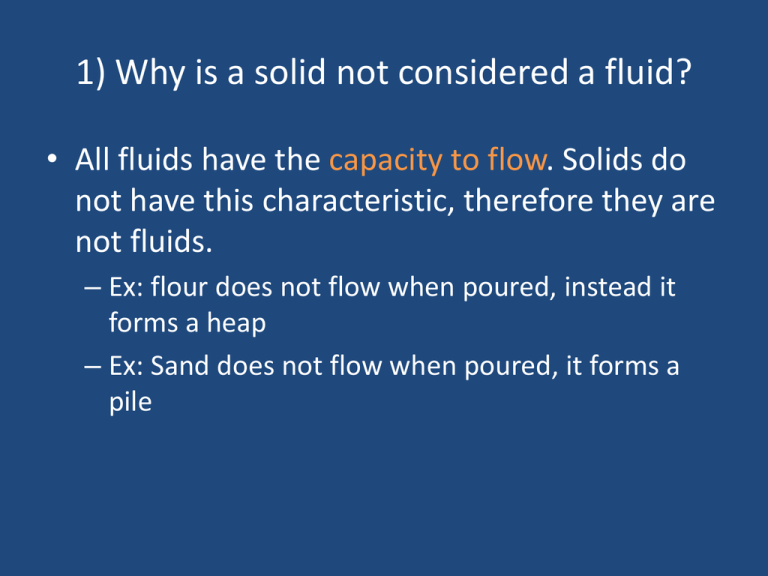
1) Why is a solid not considered a fluid? • All fluids have the capacity to flow. Solids do not have this characteristic, therefore they are not fluids. – Ex: flour does not flow when poured, instead it forms a heap – Ex: Sand does not flow when poured, it forms a pile 2) Do all fluids flow equally easily? Explain. • All fluids do not flow equally easily as they each have a characteristic viscosity which affects their ability to flow. – Ex: due to the nature of it’s particles, molasses is very viscous and therefore does not flow as easily as water 3) What is viscosity? • Viscosity is a measure of a liquid’s resistance to flow, in other words it’s ‘thickness’. 4) Why is viscosity an important characteristic? • Viscosity is an important characteristic for engineers to consider when they are designing machinery or distribution systems. – Ex: it is important to consider a liquid’s viscosity when designing a pipeline for it’s transport – Ex: industrial lubricants must be designed with a specific viscosity so the fluid may protect mechanical parts from the effects of friction 5) What does the particle theory of matter state? • All matter is made up of tiny particles. • These particles are constantly moving. 6) How are the position of the particles in solids, liquids and gases different? • Solids: particles are held in fixed positions so that they move together. • Liquids: particles are packed closely; however, they have freedom of movement so that they may move independently from one another • Gases: particles are spaced far apart so that they may move freely past one another. Particles of a solid, liquid and gas Solid liquid gas 7) Using particle theory, explain why liquids and gases can flow and solids can’t. • Solids cannot flow because their particles are held so tightly together that they cannot move freely past one another (cannot flow) • The particles are liquids and gases can move independently and therefore may move past one another, or flow. 8) What is pressure? Explain and give the formula used to calculate pressure. Definition: Pressure is the measurement of force exerted on a surface (area) P=F A P = Pressure in N/m2 F = Force in N (Newtons) A = Area in m2 9) What 2 factors does the amount of pressure depend on? • Pressure depends on: – the size of the force – The total area on which the force acts 10) What happens to the pressure when force is increased? Pressure and Applied Force • Pressure varies in direct proportion to the force applied • When the size of the surface area is the same: – The stronger the force the greater the pressure – The weaker the force the lower the pressure • Example: – The force exerted by water increases as you dive deep down, this causes the pressure to increase which changes the shape of your eardrums causing a painful sensation 11) What happens to pressure when surface area is increased? Pressure and Surface Area • Pressure is inversely proportional to the surface area upon which force is applied • With a constant force: – The larger the surface area, the smaller the pressure – The smaller the surface area, the greater the pressure • Example: – This is why standing on a single nail would pierce through your foot whereas lying on a bed of nails would support your body weight P=F A P=F A 12) Why can a person walk on snow with snow shoes but not with regular shoes? • A person can walk on snow with snow shoes but not with regular shoes because snow shoes increase the surface area on which the force (person’s weight) is acting, thus decreasing the total amount of pressure. 13) What can one do to increase pressure without changing the force? • Decrease surface area. 14) What does ‘incompressible’ mean? • Incompressible means that the volume doesn’t change when pressure is applied. 15) What does ‘compressible’ mean? • Compressible means that when pressure is exerted, the fluid will shrink, or it’s volume will decrease 16) Why are gases compressible when liquids and solids are not? • Gases are compressible because in their natural state, their particles have enough space between them that they may be brought closer together when pressure is applied. • Liquids and solids are incompressible because their particles are already so close together that they may not be brought any closer, even with a large amount of pressure. 17) Give an example of how compressed air is used. • Compressed air is used in submarines. 18) What is the standard SI unit measurement for pressure? Units of Pressure • Pa (pascal)- this is the unit used in the international metric system (SI) • 1 Pa = 1N/m2 • 1 000 Pa = 1k Pa (kilopascal) There are also 2 other types of units used: • Mm of Hg (millimeters of mercury) • Atm (atmosphere) 19) Why does pressure increase as a person goes further and further underwater? • This is because there is a greater force of gravity pulling on the fluid as you go further and further down. 20) Would the pressure be greater under fresh water or sea water? Why? • This is because pressure is also affected by the density of the fluid. The greater the density of the fluid, the more pressure would be exerted.


